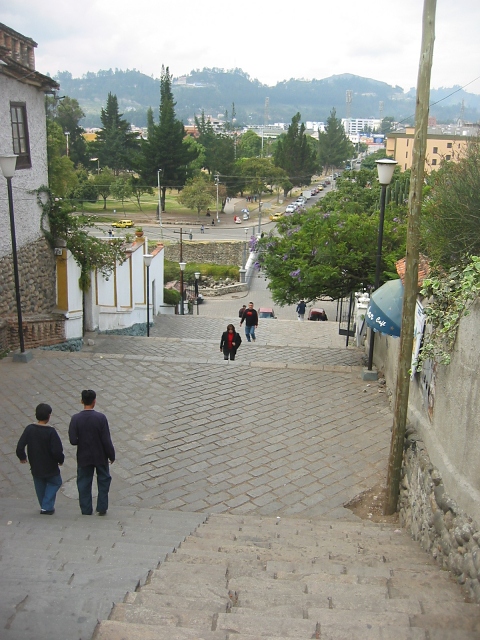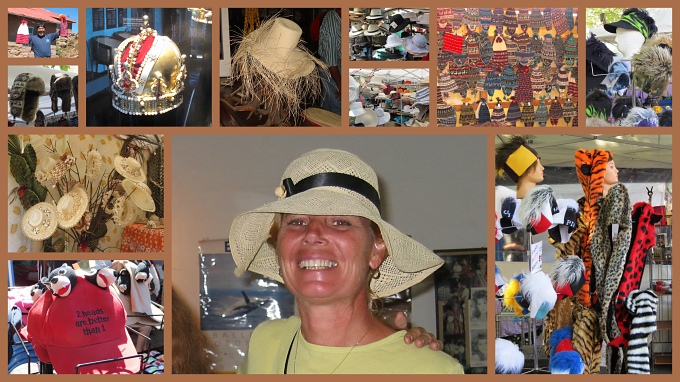
I read recently that Ecuador is the #1 best place for ex-pats to retire. We have differing views on this topic (another blog post in the future), but reading the article and having spent lots of time in Ecuador, we'd have to say that if we planned to retire in Ecuador, Cuenca would probably top our list as the best place to land. Of all the travel we did in Ecuador and all the places we visited, we returned time and time again to Cuenca for 3-4 day romantic getaways. It's that lovely.
Santa Ana de los cuatro rios de Cuenca … even its full name conjures up romance and images of Spanish conquistadors. Located in the highlands of Ecuador, Cuenca is the provincial capital and Ecuador's third largest city. Old blends with new here. Indigenous culture blends with European Spanish culture. The city center is a UNESCO World Heritage Trust site and each street seems to offer a look into the city's history.
Here's our recommendation for the things to see and do:

1. Immaculate Conception Cathedral and Parque Calderon
This distinctive blue-domed cathedral is huge and takes up a full city block. Located at Parque Calderon, Cuenca's main plaza, it's worth a visit or if you're feeling so inclined, take in a Spanish Mass. The park offers a wonderful place to sip your morning coffee or rest your feet after walking all day. We found the domes best photographed from the gazebo on the other side of the park.

2. Museo de las Culturas Aborigenes
The city has several fine museums, but we sought out one of the more unusual ones. Museo de las Culturas Aborigenes is a private museum specializing in pre-Colombian cultures in Ecuador. We found the “tsa tsas” (shrunken heads) particularly interesting and, in fact, we bought a small replica as a souvenir for our son, who hangs it on his Christmas tree each year. $2/admission. Small café, nice gift shop.

3. Rio Tomebamba Walk
We enjoyed a self-directed walking tour along the banks of the Rio Tomebamba. There are stairs leading down to the river and a lovely cobblestone pathway with lots of flowers and colonial homes and buildings line the way. Especially nice in the early morning!

4. Parque Nacional Cajas (Cajas National Park)
You can choose the bus route that takes you through the national park and the views are splendid (until the fog rolls in). You can take a tour, a bus or drive from Cuenca. It's only 20 miles (30km) outside the city. It reminded us of parts of Colorado and Utah with the rugged terrain of mesas and arroyos. There's trout fishing, hiking and pure beauty to be experienced.

5. Ice cream
Aha … now we're talking. We think the best ice cream in Ecuador is found in Cuenca. There are several ice cream shops in town. Tutto Freddo offers great ice cream sundaes and banana splits (large and pricey). Across the street Heladeria Holandesa is more economical, but the quantity, quality and presentation aren't quite as spectacular.

6. Markets and Crafts
There are markets galore in Cuenca. You name it, it’s here. Baskets, brass bells, copper pots, clay pots, ceramic piggy banks, wrought iron locks, saddles, BBQ grills, cheap jewelry, on and on and on. Long stemmed roses 25 cents each! can be found at the fresh flower market at Plazoleta del Carmen just outside the church. Casa de Mujer offered a “mall” of artisans’ stalls with various wares crafted by local people.
7. Restaurants
Eating local food is part of experiencing the local culture. The local “trucha” (trout) is excellent. You can also try “cuy”, roast guinea pig here or goat. Many restaurants serve traditional Ecuadorian food and sometimes offer live Ecuadorian music and dancing in the evenings. See our restaurant recommendations in the “If you go” section below.

8. Incan ruins
Though evidence exists that people inhabited this area since the 8th century BC, it is the 15th century Incans who have left their mark. Check out the Incan ruins in town or take a tour to Ingapirca (7 hours away) to see more.

9. Wander aimlessly
One of our favorite pastimes wherever we travel is to spend some time just wandering around. You see all sorts of unexpected sights. Cuenca is a fine city for wandering. There are lots of historical buildings, cobble-stoned streets, plazas and shops.
10. Distinctive souvenirs
We always try to look for items that are unique to an area and Cuenca offers some interesting choices. Even if you don't want a replica tsa tsa, there's quite a bit to choose from.

Ecuador is the home of Panama hats and Cuenca's hat shops are especially noted for their fine quality. There are many shops, but we especially liked the friendly people at Barranco. Hats of differing quality ranged from $-$$$$. They will also clean and re-block your hat for you at no charge.

Artesa is Ecuador’s leading pottery/ceramic manufacturer and their factory store is located here. We found the pottery patterns and styles to be very unusual and the prices extremely reasonable.

Atop many clay-roofed Cuencan houses sit ornate, black wrought-iron crosses. They can be purchased at some of the markets and the craft stalls.

Zhumir, the local aquardiente is rough stuff, but its home is Cuenca and well, if you're here, you gotta try it.
If you go:
Bus travel is easy and cheap in Ecuador and as cruisers, that was our main form of transportation. It also afforded us a chance to see the countryside and get a feel for the small towns along the way. You can, however, fly into Cuenca.
There are lots of hotels to choose from. For the budget-minded (like us), we stayed at the Hotel Milan. It was inexpensive, clean, centrally located and included an en suite bath and breakfast. Room 206 overlooks Plaza San Francisco. A double bed for a couple is called a “matrimonial”.
If you're interested in an indigenous homestay, consider Mama Kinua Cultural Center. This is a Quechua-operated enterprise that offers tours, accommodation and participation in indigenous village life.
Lonely Planet Ecuador was our guide of choice.
The temperature, especially in the evenings, is cool. Pack appropriately.
Pick up a city map and tourist information at the bus terminal or most souvenir shops and hotels in town.
Restaurants are plentiful. There's everything from pizza to sushi. We travel on a budget, but in general, prices are very reasonable. Set-priced lunches (almuerzos) are quite the bargain. Here are some of the restaurants that we tried:
Los Capulies - good food, service and prices; sometimes live Ecuadorian music and dancing in the evenings.
Café Eucalyptus – varied “world” menu; good, but pricey.
Café Austria – Great sandwiches and pastries; excellent “almuerzo”
Restaurant El Jardin in the Hotel Victoria is supposedly quite good, but we found it pricey and mediocre.
Hostal Colonial – the restaurant here looked great, but the food was mediocre.
Kookaburra Café offers a good cup of tea and English-type meals. Run by an Australian couple, it's a good place to meet fellow travelers, ex-pats and speak English.
This is by no means meant be an exhaustive list, but rather what we did ourselves and enjoyed. There are lots of sights we missed. Things change and cities like Cuenca need to be explored to be truly appreciated.






















